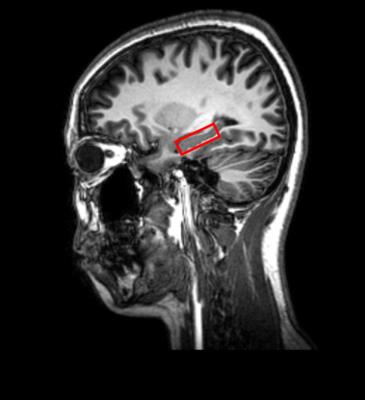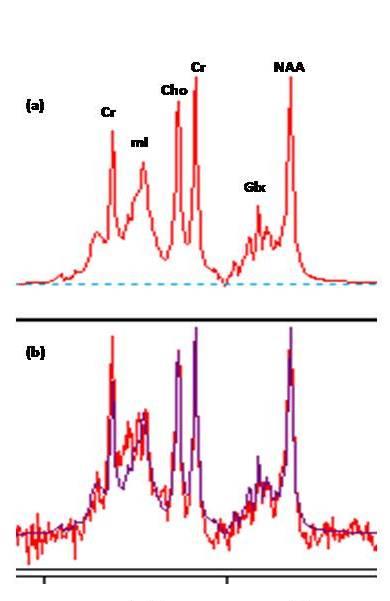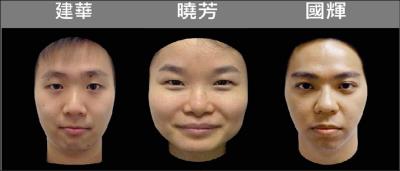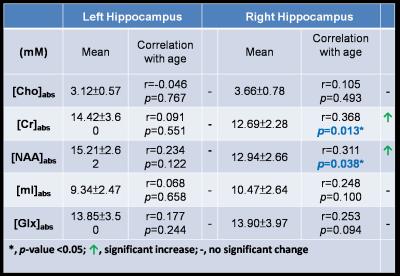4279
Memory Recall Accuracy is Associated with Glutamatergic Neurotransmission in the Right Hippocampus1Department of Diagnostic Radiology, The University of Hong Kong, Hong Kong, Hong Kong, 2State Key Laboratory of Brain and Cognitive Sciences, The University of Hong Kong, Hong Kong, Hong Kong, 3Department of Special Education and Counselling, The Education University of Hong Kong, Hong Kong, Hong Kong, 4Sau Po Centre on Ageing, The University of Hong Kong, Hong Kong, Hong Kong, 5Department of Social Work and Administration, The University of Hong Kong, Hong Kong, Hong Kong, 6Philips Healthcare, Hong Kong, Hong Kong, Hong Kong, 7Alzheimer's Disease Research Network, The University of Hong Kong, Hong Kong, Hong Kong
Synopsis
Memory for face–name associations is an important type of memory in our daily lives, and often declines in older adults, but the neural mechanisms underlying such decline are still unknown. In this study, quantitative proton magnetic resonance spectroscopy was used to investigate the metabolic changes in the bilateral hippocampi in a local Chinese cohort at 3.0T. The relationship between metabolite concentrations and memory recall accuracy from a face-name recognition task was also assessed. Right hippocampus revealed the plausibility of compensation activity during aging, and the memory recall accuracy was associated with alterations in glutamatergic neurotransmission.
Purpose
Memory for face–name associations is an important type of memory in our daily lives, and often deteriorates in older adults.1 There is converging evidence suggesting that one of the primary roles of the hippocampus in episodic encoding is to form new associations between previously unrelated items of information. Nevertheless, little is known about the neural mechanisms underlying the age-related decline in memory with controversial findings reporting older adults had a significantly larger magnitude of activation than younger adults when performing famous name recognition,2 and significant decline in the retrieval of face–name associations for newly learned people in older adults in previous fMRI studies.3 In this study, we investigated the metabolic changes during aging in the bilateral hippocampi of a local Chinese cohort using quantitative proton magnetic resonance spectroscopy (1H-MRS). In addition, the subjects also performed a face-name recognition task. The relationship between metabolite concentrations and memory recall accuracy will be assessed.Methods
45 cognitively normal (Mini-mental State Examination≥28; Montreal Cognitive Assessment≥26) subjects (mean = 50.5±16.4 years, age range 24-84 years) underwent MR scan using 3.0T Philips scanner. Two PRESS (TR/TE = 2000/39 ms) single voxels of 25 x 15 x 10 mm3 were placed in the left hippocampus (LH) and right hippocampus (RH) (Figure 1). Choline (Cho), creatine (Cr), N-acetyl aspartate (NAA), myo-inositol (mI), and summation of glutamate and glutamine complex (Glx), were measured and quantified using internal water as reference by QUEST in jMRUI (4.0) (Figure 2). Cerebrospinal fluid (CSF) normalization, water content correction for grey matter, white matter and CSF, and correction factors for T1 and T2 relaxation were also implemented. In addition, the subjects also underwent a face-name recognition task which is adapted from a prior study4 and consisted of 24 Chinese faces, 12 male and 12 female, with neutral expressions (Figure 3). During the retrieval phase of the task, each of 24 learned faces was presented with two learned names, and participants were asked to choose the correct name associated with the face. Pearson correlation coefficient (r) was calculated to assess any correlation between 1) absolute metabolite concentrations and age in bilateral hippocampi, and 2) absolute metabolite concentrations and performance of face-name recognition task (memory recall accuracy and reaction time). SPSS version 20.0 was used for statistical analysis and level of significance was set at 0.05.Results
Table 1 shows mean absolute metabolite concentrations, and their correlations with age in the bilateral hippocampi. No age-related metabolite changes were shown in the LH, where as in the RH, absolute concentrations of Cr ([Cr]abs) (r = 0.368; p = 0.013) and [NAA]abs (r = 0.311; p = 0.038) showed significant positive correlations with age. Table 2 shows mean behavioral data, and its correlation with age. Only [Glx]abs in RH showed significant negative correlation with recall accuracy (r =- 0.313; p = 0.036) and positive correlation with reaction time (r = 0.329; p = 0.027).Discussion
The finding of significant age-related increase of [NAA]abs in the RH is consistent with a previous study5 indicating the plausibility of compensation activity as NAA is a mature neuronal marker. As for age-related increase of [Cr]abs, it could be suggestive of increasing number of glial cells as reported in prior studies.6,7 In addition, it is surprising that only RH revealed age-related metabolic alterations since previous fMRI studies showed only the RH, instead of LH or bilateral hippocampi, showed increased activation in elderly adults compared to young adults during famous name recognition,2 and retrieving autobiographical events.8
[Glx]abs can act as a central measure for glutamatergic neurotransmission by assessing the entire brain pool of Glu and Gln within the Glu-Gln cycle. For the significant negative correlation between [Glx]abs and recall accuracy, it could only imply that glutamatergic neurotransmission would have influence on memory recall accuracy while the underlying mechanism is still largely unknown and remains to be investigated.
For the significant positive correlation between [Glx]abs and reaction time, it would be very likely it is contributed by the factor of aging as [Glx]abs showed an increasing trend with age while reaction time is significantly positively correlated with age.
Conclusion
RH revealed the plausibility of compensation activity during aging, and alterations in glutamatergic neurotransmission would have influence on memory recall accuracy.Acknowledgements
No acknowledgement found.References
1. Tsukiura T, Sekiguchi A, Yomogida Y, et al. Effects of Aging on Hippocampal and Anterior Temporal Activations during Successful Retrieval of Memory for Face–Name Associations. Journal of Cognitive Neuroscience 2010;23(1): 200-213
2. Nielson KA, Douville KL, Seidenberg M, et al. Age-related functional recruitment for famous name recognition: an event-related fMRI study. Neurobiol Aging 2006;27:1494–1504
3. Moshe N, Guez J, Kilb A, et al. The associative memory deficit of older adults: Further support using face–name associations. Psychology and Aging 2004;19(3): 541-546
4. Sperling RA, Bates JF, Cocchiarella AJ, et al. Encoding Novel Face-Name Associations: A Functional MRI Study. Human Brain Mapping 2001;14:129–139
5. Chiu PW, Mak HK, Yau KK, et al. Metabolic changes in the anterior and posterior cingulate cortices of the normal aging brain: proton magnetic resonance spectroscopy study at 3 T. Age (Dordr) 2014;36(1): 251-264
6. Charlton RA, McIntyre DJO, Howe FA, et al. The relationship between white matter brain metabolites and cognition in normal aging: the GENIE study. Brain Research 2007;1164:108–116
7. Reyngoudt H, Claeys T, Vlerick L,et al. Age-related differences in metabolites in the posterior cingulate cortex and hippocampus of normal ageing brain: a 1H-MRS study. Eur J Radiol 2012;81:e223–e231
8. Maguire EA, Frith CD. Aging affects the engagement of the hippocampus during autobiographical memory retrieval. Brain 2003;126:1511–1523
Figures




